Visual effects of the movie Thing in Wednesday

Related Movies:
Related Movies:
Related Movies:
I believe you’re referring to the visual effects used to create the character Thing in the Netflix series Wednesday, rather than a movie titled Thing. Thing is the iconic sentient, disembodied hand from The Addams Family franchise, and the series Wednesday (premiered November 23, 2022) brought this character to life through a blend of practical and visual effects. Below is a detailed explanation of how Thing’s visual effects were achieved, based on available information.
Visual Effects for Thing in Wednesday
- Live Actor Performance:
- Thing was portrayed by Romanian magician and first-time actor Victor Dorobantu, whose natural dexterity and experience with close-up magic were key to the character’s expressive movements. His background in sleight-of-hand and misdirection allowed for dynamic and nuanced hand gestures that gave Thing a distinct personality.
- Dorobantu wore a full-body blue chroma-key suit, covering everything except his hand, which allowed the visual effects team to digitally remove his body in post-production, leaving only the hand visible. This suit helped him focus on channeling his performance through his hand, as he could mentally “ignore” the rest of his body.
- Prosthetic Stump:
- A critical element was the prosthetic “stump” attached to Dorobantu’s wrist, designed to create the illusion of a severed hand. Multiple versions (3–5 stumps) were used, each tailored for specific scenes or movements, with playful names like “lazy stump” or “straight stump.” These prosthetics, inspired by the 1991 The Addams Family film, featured stitches and a Frankenstein-like texture to suggest a backstory of being severed and stitched back together, adding character depth.
- The stumps reduced the need for extensive rotoscoping and compositing, making the effect more convincing than earlier depictions (e.g., the 1964 series, where an actor’s arm extended from a box).

- Practical Effects and On-Set Techniques:
- Around 90% of Thing’s scenes relied on practical effects, with Dorobantu performing live on set. He often had to contort his body into unusual positions—hiding under beds, in holes, behind walls, or on a moving camera trolley—to capture the right angles for Thing’s movements. For example, in one scene, he was positioned under a desk with his arm through a hole to simulate Thing “talking” to Wednesday.
- Director Tim Burton insisted on using a real actor over full CGI to maintain authenticity, with scenes shot alongside actors like Jenna Ortega (Wednesday) to ensure natural interactions. Dorobantu’s improvisation, incorporating elements of ASL, scuba diving signals, and military signs, created a unique “language” for Thing, enhancing its emotional expressiveness without relying solely on CGI.
- Visual Effects Enhancements:
- While primarily practical, about 10% of Thing’s scenes used CGI to refine the illusion, particularly to ensure the hand appeared gravitationally grounded on surfaces as it moved. The VFX team, led by supervisor Tom Turnbull, used digital paint-out techniques to remove Dorobantu’s body, leveraging the blue suit for cleaner compositing.
- In complex shots where practical filming wasn’t feasible, full CG hand animation was employed, but the goal was to replicate Dorobantu’s performance as closely as possible to maintain consistency. The VFX team at MARZ (Monsters Aliens Robots Zombies) spent over a year ensuring seamless integration between live-action and CG elements, especially in close-up shots where Thing’s movements were scrutinized.
- Unlike other VFX-heavy elements in Wednesday (e.g., the Hyde monster, which relied more on CGI and was less well-received), Thing’s blend of practical and digital effects was praised for its realism and charm.

- Character Design and Aesthetic:
- Emmy-winning prosthetic designer Tristan Versluis collaborated with Burton to give Thing a distinct look, incorporating scars and stitches to hint at a mysterious origin story. This design choice added a gothic, weathered texture compared to the pristine hand in earlier Addams Family adaptations.
- The VFX team worked closely with Dorobantu to plan each scene, choosing specific stumps and angles to match the action, ensuring Thing’s movements felt organic and character-driven rather than gimmicky.
- Behind-the-Scenes Challenges:
- Filming required extensive preparation, with Dorobantu spending up to three hours in hair and makeup to apply the prosthetic stump. The VFX team used gray and silver balls and color charts between takes to calibrate lighting and ensure accurate CGI integration.
- Dorobantu’s performance was physically demanding, requiring him to maintain awkward positions for long periods, yet his dedication and improvisation made Thing a fan favorite, often described as the “hero” or “star” of the series.











